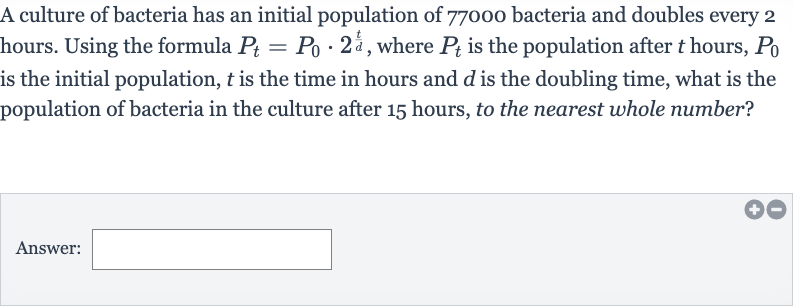AI tutor
Welcome to Bytelearn!
Let’s check out your problem:

A culture of bacteria has an initial population of bacteria and doubles every hours. Using the formula , where is the population after hours, is the initial population, is the time in hours and is the doubling time, what is the population of bacteria in the culture after hours, to the nearest whole number?Answer:
Full solution
Q. A culture of bacteria has an initial population of bacteria and doubles every hours. Using the formula , where is the population after hours, is the initial population, is the time in hours and is the doubling time, what is the population of bacteria in the culture after hours, to the nearest whole number?Answer:
- Identify initial population and doubling time: Identify the initial population and the doubling time . The initial population of bacteria, , is given as bacteria. The doubling time, , is given as every hours.
- Write population formula: Write down the formula for the population after hours.The formula given is , where is the population after hours, is the initial population, is the time in hours, and is the doubling time in hours.
- Substitute given values: Substitute the given values into the formula.We need to find the population after hours, so . The initial population is , and the doubling time is hours. Substituting these values into the formula gives us:
- Calculate the exponent: Calculate the exponent.To calculate , we first divide by , which gives us . Then we raise to the power of .
- Calculate : Calculate . Using a calculator, we find that is approximately .
- Multiply by growth factor: Multiply the initial population by the growth factor.Now we multiply the initial population of by the growth factor we just calculated.
- Calculate final population: Calculate the final population. Multiplying by gives us approximately .
- Round to nearest whole number: Round the population to the nearest whole number.The population of bacteria after hours, rounded to the nearest whole number, is approximately .
